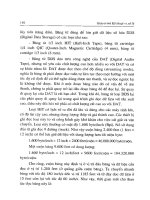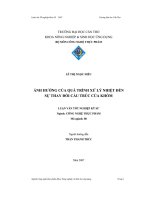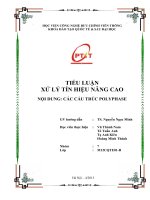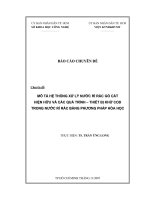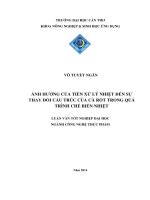VI XỬ LÝ Vxl ch03 8051 3 9 cau truc va tk chuong trinh
Bạn đang xem bản rút gọn của tài liệu. Xem và tải ngay bản đầy đủ của tài liệu tại đây (324.8 KB, 48 trang )
System & Program
Developments of 8051
Program Structure and Design
Introduction
Advantages and Disadvantages of Structured
Programming
The Three Structures: statements, loops, choice
Pseudo Code Syntax
Assembly Language Programming
Tools & Techniques for Program
Development
The Development Cycle
Integration and Verification
Command and Environments
2011/12/7
T. L. Jong, Dept. of E.E., NTHU
1
Introduction
Structured Programming:
Organizing and coding programs that reduces
complexity, improves clarity, and facilitates
debugging and modifying
All programs may be written using only three
structures: statements, loops, and choice—too
good to be true.
Introduce Structure programming to
assembly language programming
2011/12/7
Flowcharts
Pseudo code
Assembly language
T. L. Jong, Dept. of E.E., NTHU
2
Flowcharts
Decision block
Off-page connector
Process box
Predefined process
(subroutine)
Input/Output block
Program flow arrow
Program terminator
2011/12/7
T. L. Jong, Dept. of E.E., NTHU
3
Pseudo Code
Strict
adherence to structure in
combination with informal language
[get a character from the keyboard]
IF [condition is true]
THEN [do statement 1]
ELSE BEGIN
[do statement 2]
[do statement 3]
END
2011/12/7
T. L. Jong, Dept. of E.E., NTHU
4
Advantages & Disadvantages of
Structured Programming
Advantages:
Simple to trace, debug
Finite number of structures
Structures as building block
The set of structure is complete
Structures are self-documenting, easy
to read
Structures are easy to describe in
flowcharts, syntax diagrams, pseudo
code,..
Increased program productivity
2011/12/7
T. L. Jong, Dept. of E.E., NTHU
5
Advantages & Disadvantages of
Structured Programming
Disadvantages:
Only
a few high-level languages (Pascal,
C, PL/M) accept the structures directly;
others require extra translation stage
Structured program may execute slower
and require more memory
Some problems (a minority) are more
difficult to solve using only the three
structures
Nested structures can be difficult to
follow
2011/12/7
T. L. Jong, Dept. of E.E., NTHU
6
The Three Structures
Statements
[count
= 0]
PRINT_STRING(“Select Option:”)
Loops
(iteration)
WHILE/DO
REPEAT/UNTIL
Choice
IF/THEN/ELSE
CASE
2011/12/7
T. L. Jong, Dept. of E.E., NTHU
7
The WHILE/DO Statement
WHILE [condition] DO
[statement]
(statement might not be performed at all!)
Enter
Condition
True?
WHILE [c == 1] DO
[statement]
No
ENTER:
STATEMENT:
Yes
EXIT:
Statement
2011/12/7
JNC
EXIT
(statement)
JMP
ENTER
(continue)
Exit
T. L. Jong, Dept. of E.E., NTHU
8
WHILE/DO: SUM Subroutine
[sum (A) = 0]
WHILE [length (R7) > 0] DO BEGIN
[sum = sum + @pointer (R0)]
[increment pointer]
[decrement length]
END
8051 code (closely structured; 13 bytes)
(loosely structured; 9 bytes)
SUM: CLR A
LOOP: CJNZ R7,#0,STAM
JMP EXIT
STAM: ADD A,@R0
INC R0
DEC R7
JMP LOOP:
EXIT: RET
SUM:
2011/12/7
CLR
INC
MORE: DJNZ
RET
SKIP: ADD
INC
SJMP
T. L. Jong, Dept. of E.E., NTHU
A
R7
R7,SKIP
A,@R0
R0
MORE
9
WHILE/DO
Pseudo code:
WHILE [ACC != CR AND R7 != 0] DO
[statement]
Enter
ACC !=
<CR>?
8051 code:
ENTER:
No
Yes
No
R7 != 0?
Yes
Statement
2011/12/7
Exit
CJNE A,#0DH,SKIP
JMP
EXIT
SKIP:
CJNE R7,#0,STAM
JMP
EXIT
STAM: (one or more statements)
.
.
JMP
ENTER
EXIT:
(continue)
T. L. Jong, Dept. of E.E., NTHU
10
The REPEAT/UNTIL Statement
REPEAT
[statement]
UNTIL
[condition]
(statement performed at least once)
Enter
REPEAT
UNTIL
[statement]
[c == 1]
Statement
No
Condition
True?
ENTER: (statement)
JNC
ENTER
EXIT: (continue)
Yes
Exit
2011/12/7
T. L. Jong, Dept. of E.E., NTHU
11
The REPEAT/UNTIL Statement
REPEAT
UNTIL
[ACC = @pointer]
[increment pointer]
[ACC == ‘Z’ or ACC == 0]
Enter
8051 code:
Get a char
Inc pointer
No
Char =
“Z”?
Yes
No
STAM: MOV
INC
JZ
CJNE
EXIT: RET
A,@R0
R0
EXIT
A,#’Z’,STAM
Char =
0?
Yes
Exit
2011/12/7
T. L. Jong, Dept. of E.E., NTHU
12
The IF/THEN/ELSE Statement
IF
[condition]
THEN [statement 1]
ELSE [statement 2]
Enter
No
condition
true?
Statement 2
Yes
Statement 1
Exit
2011/12/7
T. L. Jong, Dept. of E.E., NTHU
13
The IF/THEN/ELSE Statement
[input character]
IF [input character == graphic]
THEN [echo character]
8051 code:
ELSE [echo ‘.’]
Enter
Input character
No
Graphic
char?
Echo “.”
Echo char
Exit
2011/12/7
Yes
(closely structured; 14 bytes)
ENTER:
ACALL INCH
ACALL ISGRPH
JNC
STMENT2
STMENT1:
ACALL OUTCH
JMP
EXIT
STMENT2:
MOV
A,#’.’
ACALL OUTCH
EXIT:
(continue)
(loosely structured; 10 bytes)
ACALL INCH
ACALL ISGRPH
JC
SKIP
MOV
A,#’.’
SKIP:
ACALL OUTCH
(continue)
T. L. Jong, Dept. of E.E., NTHU
14
The CASE Statement
Enter
CASE [expression] OF
0: [statement 0]
1: [statement 1]
2: [statement 2]
.
.
N: [statement 0]
[default]
END_CASE
expression No expression No expression No
0?
1?
2?
Yes
Statement 0
Yes
Statement 1
Yes
Statement 2
expression
n?
No
Yes
Statement n
default
Exit
2011/12/7
T. L. Jong, Dept. of E.E., NTHU
15
The CASE Statement
[input a character]
CASE [character] OF
‘0’: [statement 0]
‘1’: [statement 1]
‘2’: [statement 2]
‘3’: [statement 3]
END_CASE
Enter
Input
character
char
== “0”?
Yes
Action 0
No
char
== “1”?
Yes
Action 1
No
char
== “2”?
No
Yes
Action 2
char
== “3”?
No
Yes
Action 3
Exit
2011/12/7
T. L. Jong, Dept. of E.E., NTHU
16
The CASE Statement
8051 code:
(closely structured)
ACALL INCH
CJNE
A,#’0’,SKIP1
ACT0:
.
.
JMP
EXIT
SKIP1: CJNE
A,#’1’,SKIP2
ACT1:
.
.
JMP
EXIT
SKIP2: CJNE
A,#’2’,SKIP3
ACT2:
.
.
JMP
EXIT
SKIP3: CJNE
A,#’3’,EXIT
ACT3:
.
.
EXIT:
2011/12/7
(continue)
(loosely structured)
ACALL INCH
ANL
A,#3
;reduce to 3 bits
RL
A
MOV
DPTR,#TABLE
JMP
@A+DPTR
TABLE: AJMP
ACT0
AJMP
ACT1
AJMP
ACT2
ACT3:
.
.
JMP
EXIT
ACT0:
.
.
JMP
EXIT
ACT1:
.
.
JMP
EXIT
ACT2:
.
.
EXIT:
(continue)
T. L. Jong, Dept. of E.E., NTHU
17
The GOTO Statement
2011/12/7
GOTO statement can always be avoided by
using the structures. Sometimes GOTO
statement provides an easy method of
terminating a structure when errors occur.
GOTO statements usually becomes
unconditional jump in assembly
implementation. Extreme caution is needed.
Never exit a subroutine using GOTO instead
of normal return for the return address will
be left on the stack and eventually stack
overflow will occur.
T. L. Jong, Dept. of E.E., NTHU
18
Pseudo Code Syntax
Tips of using pseudo code:
Use descriptive language for statements
Avoid machine dependency in statements
Enclose conditions & statements in brackets: []
Begin all subroutines with their names followed
by a set of parameters: ()
End all subroutine with RETURN ()
Use lower text except reserved words &
subroutine names
Indent all statements from the structure entry
points and exit points
Use the commercial at sign (@) for indirect
addressing
2011/12/7
T. L. Jong, Dept. of E.E., NTHU
19
Suggested Pseudo Code Syntax
Reserved words:
BEGIN
END
REPEAT UNTIL
WHILE
DO
IF
THEN
ELSE
CASE
OF
RETURN
Arithmetic operators:
+ addition
subtraction
* multiplication
/
division
% modulus (remainder after division)
2011/12/7
T. L. Jong, Dept. of E.E., NTHU
20


